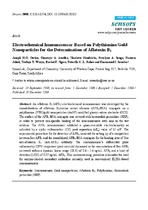Electrochemical immunosensor based on polythionine/gold nanoparticles for the determination of Aflatoxin B1
Date
2008Author
Owino, Joseph H.O.
Arotiba, Omotayo A.
Hendricks, Nicolette
Songa, Everlyne
Jahed, Nazeem
Waryo, Tesfaye T.
Ngece, Rachel F.
Baker, Priscilla
Iwuoha, Emmanuel I.
Metadata
Show full item recordAbstract
An aflatoxin B1 (AFB1) electrochemical immunosensor was developed by the
immobilisation of aflatoxin B1-bovine serum albumin (AFB1-BSA) conjugate on a
polythionine (PTH)/gold nanoparticles (AuNP)-modified glassy carbon electrode (GCE).
The surface of the AFB1-BSA conjugate was covered with horseradish peroxidase (HRP),
in order to prevent non-specific binding of the immunosensors with ions in the test
solution. The AFB1 immunosensor exhibited a quasi-reversible electrochemistry as
indicated by a cyclic voltammetric (CV) peak separation (ΔEp) value of 62 mV. The
experimental procedure for the detection of AFB1 involved the setting up of a competition
between free AFB1 and the immobilised AFB1-BSA conjugate for the binding sites of free
anti-aflatoxin B1 (anti-AFB1) antibody. The immunosensor’s differential pulse
voltammetry (DPV) responses (peak currents) decreased as the concentration of free AFB1
increased within a dynamic linear range (DLR) of 0.6 - 2.4 ng/mL AFB1 and a limit of
detection (LOD) of 0.07 ng/mL AFB1. This immunosensing procedure eliminates the need
for enzyme-labeled secondary antibodies normally used in conventional ELISA–based
immunosensors.

